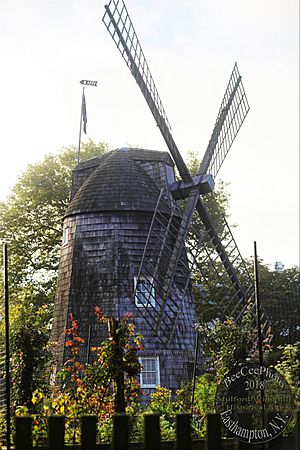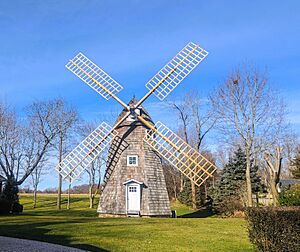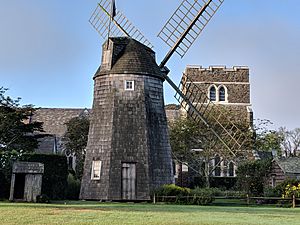Pantigo Windmill facts for kids
Quick facts for kids Pantigo Windmill |
|
|---|---|

Pantigo Windmill, September, 2018
|
|
| Coordinates | 40°57′24″N 72°11′28″W / 40.9566°N 72.1911°W |
| Information | |
| Smock sides | Eight |
| No. of sails | Four |
| Other information | |
|
Pantigo Windmill
|
|
|
U.S. Historic district
Contributing property |
|
| Lua error in Module:Location_map at line 420: attempt to index field 'wikibase' (a nil value). | |
| Location | 14 James lane., Easthampton, New York |
| Area | less than one acre |
| Built | 1644 |
| Built by | Schellinger, Samuel |
| Part of | East Hampton Village District (ID74001309) |
| Designated CP | May 5, 1984 |
The Pantigo Windmill is a special type of windmill called a smock mill. It has eight sides and is located in Easthampton, New York, on Long Island. A weathervane from 1771 sits on its top! This historic windmill was added to the National Register of Historic Places in 1984. This means it's an important building recognized for its history. It is also part of the East Hampton Village District.
Contents
The Pantigo Windmill's Story
The Pantigo Mill was built on a place called Mill Hill in East Hampton. This was the third windmill to stand on that spot. Mill Hill was made taller in 1729 when an older type of windmill, called a post mill, was moved there. That post mill was later replaced by a new windmill in 1771.
Building the Mill
Samuel Schellinger started building the Pantigo Windmill for Huntting Miller in March 1804. Samuel was a skilled builder who created several windmills in the area. He also built the Beebe Windmill in East Hampton. He even built windmills in other places like Setauket, Long Island, Brooklyn, Block Island, and Nantucket, Massachusetts. Besides windmills, Samuel also worked on boats in Sag Harbor.
Samuel Schellinger worked on the Pantigo Mill for 83 days himself. He also had helpers who worked for 144 days. Another local carpenter, David Sherril, also helped. David repaired many windmills in East Hampton. In the summer of 1804, David worked on the Pantigo Mill for 35 days. He helped build the mill's frame and worked on its "running gear," which are the parts that make the mill work.
A few months later, another windmill, the Gardiner Mill, was also being built nearby. This mill was being built by Nathaniel Dominy IV. Nathaniel Dominy V, another mill expert, later helped repair the Pantigo Windmill in 1821.
In the 1700s, laws helped millers do their job. There's a story about Huntting Miller. Once, during a church sermon, the minister heard the wind outside. He told everyone, "Church will be dismissed, Miller, go to your mill and grind!" Town law said that the minister's grain had to be ground first.
Who Owned the Pantigo Windmill?
The Pantigo Windmill changed owners many times over the years. Huntting Miller left the windmill to his grandson, Captain William Hedges, in 1832. In 1834, William had the mill's machinery fixed. Nathaniel Dominy V helped with these repairs.
In 1845, William Hedges sold the mill to David A. Hedges. David moved the windmill to his property on Pantigo Road. It was about half a mile east of the village. David Hedges then sold the mill to Hiram Sandford. Hiram moved it to the corner of Pantigo Road and Egypt Lane. The mill stayed there until 1917.
Because the mill was on Pantigo Road for 72 years, it became known as the Pantigo Windmill. Before 1865, Hiram Sandford sold the mill to Nathaniel Dominy VII. Nathaniel also owned the Old Hook Mill. A note inside the Pantigo Mill says that Nathaniel was repairing it in February 1878. He started grinding grain again on June 12, 1878.
However, Nathaniel only used the mill for about a year after these repairs. In August 1879, a big storm hit. It was described as the "heaviest since 1811." The storm broke the iron cross that held the mill's sails. Nathaniel never got the mill working again after that.
The Mill's New Home
In 1917, Gustav Buek bought the Pantigo Windmill. He moved it behind the Mulford Farmhouse on the East Hampton Common. After Mr. Buek passed away, the Village of East Hampton bought his old house and the windmill.
The American writer and actor John Howard Payne had visited this house when he was a child in the early 1800s. His grandfather owned it. Because of this, the village named the house "Home, Sweet Home," after John Howard Payne's famous song from 1822. This song made him very famous and was popular during the American Civil War.
The Village of East Hampton made big repairs to the mill in 1978-1979 and again in 1984–85. Both the house and the mill are important parts of the East Hampton Historic District.
Aquebogue Windmill: A Replica

On the North Fork of Long Island, in a small town called Aquebogue, a copy of the Pantigo Windmill was built. This replica was made to look exactly like the original. Architect Don Feiler drew the first plans for the owner, Bob Bocksel. The new windmill was finished in 2008.
In May 2022, a strong windstorm damaged this replica windmill. Its sails hit the branches of a nearby tree and were badly broken. The lattice, which is the grid that holds the sails, was also damaged. This lattice is very important for keeping the sails stable.
Bob Bocksel repaired the windmill himself. Luckily, Sylvester Manor, a group that saves historic places, had three spare sails. These sails had been in a barn since the 1950s! These three sails, plus one new sail made from scratch, were used to fix the windmill. To make the windmill stronger, the main shaft was covered in sheet metal to stop it from bending. A Maple tree that was too close to the windmill was also removed.
See also
- Samuel Schellinger


